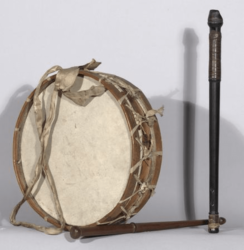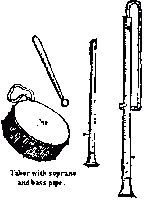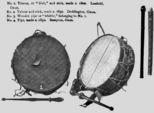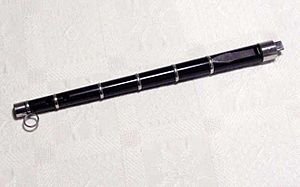Pipe and tabor facts for kids
 |
|
| Classification | |
|---|---|
| Playing range | |
| 1-2 octaves | |
| Related instruments | |
|
|
The pipe and tabor is a cool set of two musical instruments played by just one person! Imagine playing a flute and a drum at the same time. That's what a pipe and tabor player does. One hand holds a special three-hole pipe (like a small flute). The other hand uses a stick to beat a small drum called a tabor.
The tabor drum usually hangs from the player's left arm or around their neck. This way, their hands are free. The right hand holds the drumstick. The left hand plays the pipe using the thumb and first two fingers.
The pipe can be made from wood, metal, or plastic. It's a long, thin tube with three holes near one end. Two holes are in the front, and one is in the back. The other end has a mouthpiece, similar to a recorder.
Pipe and tabor instruments are found all over the world. Many different cultures have their own unique styles. This means they have different ways of playing and different musical notes. Some pipes are very small, like the Picco pipe. Others are very large, like the fujara.
In Europe, there are many types of these instruments. You can see the pipe and tabor in old pictures and carvings. They appear in old books, church carvings, and even stained glass windows.
Contents
How old are pipe and tabor instruments?
Flutes have been in Europe for a very long time. But the pipe and tabor combination became popular later. It arrived from Asia, coming through North Africa and other parts of Europe. People started seeing it in drawings around the 11th century.
Early pictures of the pipe and tabor
One of the earliest pictures of the pipe and tabor is from the 13th century. It's in a book called the Cantigas de Santa Maria. In the 17th century, a writer named Mersenne talked about a musician named John Price. He was amazing at playing the galoubet, a type of pipe.
Another writer, Michael Praetorius, wrote a book in 1618. It was called De Organographia. He showed and described three sizes of a pipe called the Stamentienpfeiff. There was a small one (20 inches), a medium one (26 inches), and a large one (30 inches). The large one needed a special curved tube to play it.
- Early descriptions
-
This picture from the 13th century shows a pipe and tabor. It's from the Crown of Castile.
-
Triumph of Scipio from The Introduction of the Cult of Cybele at Rome by Andrea Mantegna.
-
A fun picture of a bear playing the pipe and tabor. This is from a prayer book from the mid-15th century.
-
This shows a tabor with soprano and bass pipes. It was drawn by Michael Praetorius.
You can also find medieval pictures of pipe and tabor players in old sculptures and drawings from the 13th century.
What's the difference between pipe and tabor and fife and drum?
Both the pipe and tabor and the fife and drum use a wind instrument and a drum. They both play the wind instrument in its higher notes. However, there's a key difference.
The fife is a flute that you blow across, like a regular flute. It needs two hands to play. This means the drummer has to be a different person. The pipe, on the other hand, is a fipple flute, meaning you blow into the end, like a recorder. It only needs one hand to play.
The fife and drum are often linked to military marching bands. The pipe and tabor has a much older history. It was used for everyday music and fancy court events. People used it for dancing, ceremonies, parades, folk traditions, and street shows.
Pipe and tabor in England
Very old three-hole pipes made from bone have been found in England. Some date back to the early Middle Ages. You can see pictures of medieval tabor players in famous buildings. These include York Minster, Lincoln Cathedral, Gloucester Cathedral, and Tewkesbury Abbey.
During the time of Shakespeare, clowns would perform between acts of plays. They often danced to the music of the pipe and tabor.
The pipe and tabor also had other names in some parts of England. People called it whittle and dub or whit and dub. Playing the pipe and tabor continued into the 20th century. It almost disappeared for a while. But then people became interested in it again. Now, the English pipe and tabor tradition is still alive. You can see it in morris dancing, early music groups, and other cultural events.
In the 20th century, a company called Generation made affordable English tabor pipes. They were made of metal with a plastic mouthpiece. The English tabor drum has changed its shape over time. Today, you can find it in many sizes and shapes. Players choose what they like best. Traditionally, it has a snare (a string of beads or wires) on the top. But sometimes, people play it without a snare.
Where else is the pipe and tabor played?
Spain and the Pyrenees mountains
The pipe and tabor is very popular in the Basque region. It comes in different local forms. The txirula (a high-pitched flute) and the txistu are two Basque types of three-hole tabor pipes. They are tuned to a special musical scale called the dorian mode. In the Basque country, groups of players often play the pipe and tabor together.
Besides the Basque region, the pipe and tabor is important in other parts of the Iberian Peninsula (Spain and Portugal). The flauta and tamboril are common in areas like León, Castille, Extremadura, and Andalucía. In Huelva, Andalucía, the flauta or gaita and the tambor or tamboril are played during celebrations. These include Cruces de Mayo (May Crosses), sword dances, and romerías (religious pilgrimages). For the Romería of El Rocío, this pipe is called flauta rociera or pito rociero.
The Balearic Islands also have folk music with a flute and drum played together. You can hear this in the traditional music and dances of Ibiza, Formentera, and Majorca.
Provence, France
In Provence, a region in France, there's a type of tabor pipe called the galoubet. Its musical scale starts lower than the English tabor pipe. The galoubet is played with a very deep drum called the tambourin.
Pipe and tabor in the Americas
Latin America
The pipe and tabor traveled from Spain to the Americas. It is still used in some folk traditions there. The Yaqui nation in Arizona and Mexico has "Tamboristas" who play these instruments. The Tarahumara people in Mexico's Chihuahua mountains play a three-hole whistle. It's made from a type of cane. The drum they use with it is large but very thin.
In the Andes mountains (in countries like Argentina, Bolivia, Chile, Ecuador, and Peru), you also find a one-handed flute and drum combination. The Pinkillu flute and the Tinya drum are used in their traditions. Sometimes, the drum is also played with a panflute called the antara.
United States and Canada
The renewed interest in the English pipe and tabor also spread to the United States and Canada. One of the biggest makers of tabor pipes today is the Kelischeck Workshop in North Carolina. They make the Susato line of instruments.
A similar tradition once existed in the United States. People would play panpipes along with a tambourine.
See also
- Fipple
- Flabiol
- Flageolet
- Jacques de Vaucanson
- Morris dance
- Psalterium (instrument)









